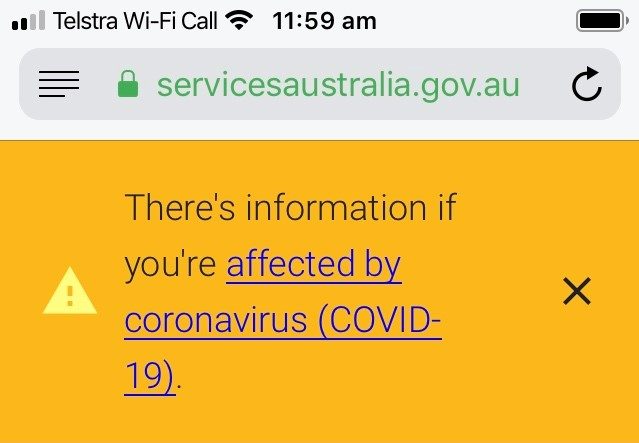 A Guide To Accessing Centrelink payments
A Guide To Accessing Centrelink payments
Please don’t ring the Services Australia (formerly Centrelink) Hotline number, and avoid going into a service centre. Try and do as much as you can online first.
We’ve included some links in this step by step guide and details on how to access Jobfind’s jobactive and Disability Employment Services.
Step 1:
Jump online and log in to your existing MyGov account or create a new one.
Step 2:
Create a Centrelink account.
You may already have an online account if you have received Centrelink benefits in the past. If so, go to step 3.
If you don’t have an online Centrelink account, but you’ve received payments in the past, try to track down any old concession cards, letters or emails from Centrelink to find your Customer Reference Number (CRN) or Customer Access Number (CAN).
If you can’t find this information, you can call Centrelink and they’ll ask you some questions to help you get your CRN.
If you’ve never received money from Centrelink, you’ll need to set up an account for the first time.
In the past this would have meant proving your identity by showing three original documents to prove your identity to Centrelink.
This is usually done in person at a Centrelink, but that has now changed.
You are no longer required to attend a Centrelink site to provide proof of identity.
Centrelink staff will give you a validation over the phone, meaning you can go online and register through MyGov without the need to provide proof of identity documents in person.
On Wednesday, 26 March, Centrelink introduced a new function which allows you to log in to MyGov and register your intent to claim.
The only information you need for this is a MyGov login, which you may already have if you use the portal to access the tax office or Medicare.
Your payments will be backdated to the date you lodged your intent to claim.
Step 3:
Log in to your MyGov account and ‘link’ it to your Centrelink account. Once this is done, you’ll be able to log into the MyGov portal and click through to your Centrelink account.
Step 4:
If you’re still working but there’s a reduction in your hours, you’ll need a letter from your employer confirming this.
In the past when someone lost their job, they needed to fill in an employment separation certificate for every employer they’d worked for in the past 12 months — but this requirement will be waived from April 27.
You will need to upload other documents throughout the claims process.
From April 27, Centrelink will also waive the requirement to provide proof of rental arrangements or verification of relationship status.
Step 5:
Making a claim.
Log in to MyGov and go to Centrelink.
Select Payments and Claims from the menu, then Claims, then Make a claim.
Choose the category that best describes your circumstance and click Get started.
You’ll have to submit any required documents online now, but you’ll have 14 days to submit any supplementary documents.
Step 6:
As part of the claim, you’ll need to book a phone appointment.
You’ll need to make a note of your appointment time and make sure your phone is with you.
Step 7:
Centrelink will let you know if your claim has been approved.
If it is, they’ll tell you when you need to report.
This may come through your MyGov inbox or the Express Plus Centrelink app or by mail.
Reporting just means letting Centrelink know how much money you earned over the past 14 days and confirming you’ve adhered to the mutual obligations laid out in your job plan.
You’ll have to report every two weeks.
If you don’t report, you won’t get paid. If you’re late reporting, your payment will be late.
You can report online or over the phone.
Do I have to apply for work to get Centrelink payments during coronavirus?
In order to keep getting the JobSeeker Payment and Youth Allowance for jobseekers, there are things you must do, like apply for jobs or undergo training.
These are called mutual obligation requirements. At Jobfind we can help you prepare your resume, enrol in training and get you job ready
For the six months starting April 27, 2020, the Government has introduced some new rules because of coronavirus.
It means sole traders and self-employed people who now earn less than $1,075 a fortnight will meet their mutual obligation requirements just by continuing to operate their business.
They won’t have to apply for other jobs.
Jobseekers who have caring responsibilities, or who need to self‑isolate, are able to seek an exemption from their mutual obligation requirements without the need for medical evidence.
Activities can be rescheduled if you are unable to attend as a result of the Coronavirus. Job Plans will be adjusted to a default requirement of four job searches a month (or one a week) to reflect softening labour market conditions.
In some circumstances, you might be able to do training or volunteer work to meet your mutual obligation requirements. Jobfind has a range of courses and training that can help with improving your job prospects once things bounce back.
The new rules also allow you to seek an exemption from your mutual obligation requirements without a doctor’s certificate if you have caring responsibilities or need to self-isolate due to the coronavirus.
You may also be exempt if your child’s school or childcare centre has closed, or you’re caring for an adult with a disability or special needs whose day service or supported workplace premise has closed.
During your exemption period, you won’t need to attend appointments, look for work or do any of the activities in your job plan.